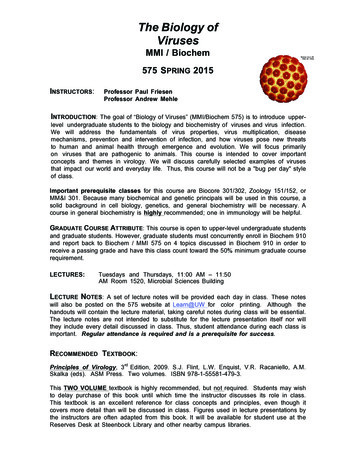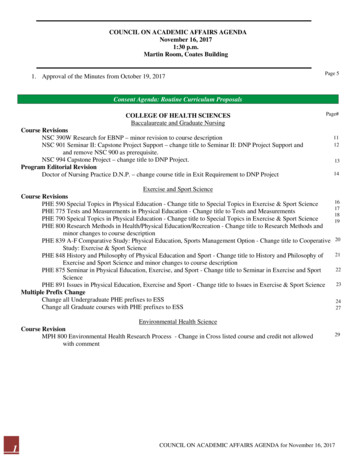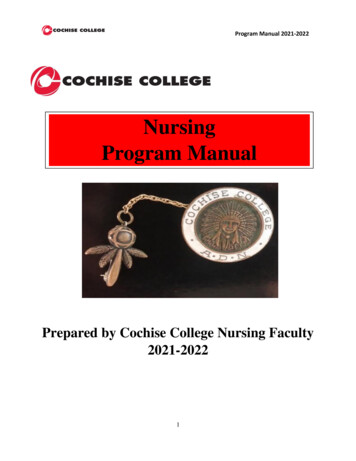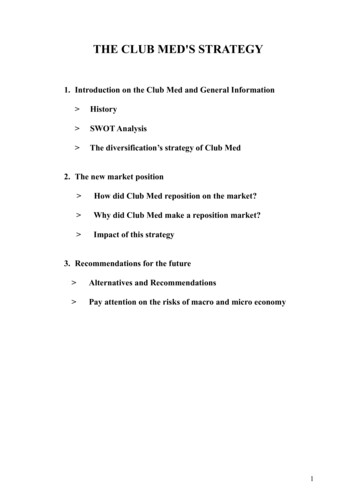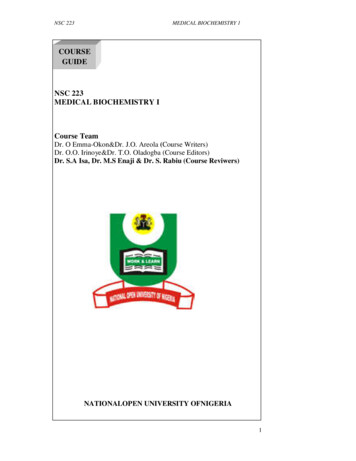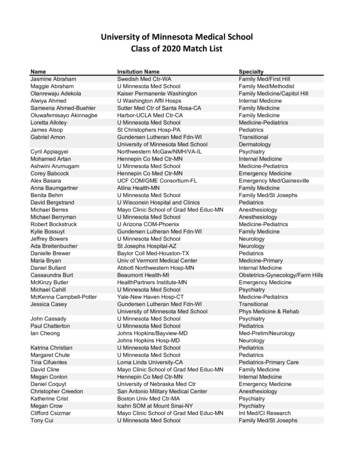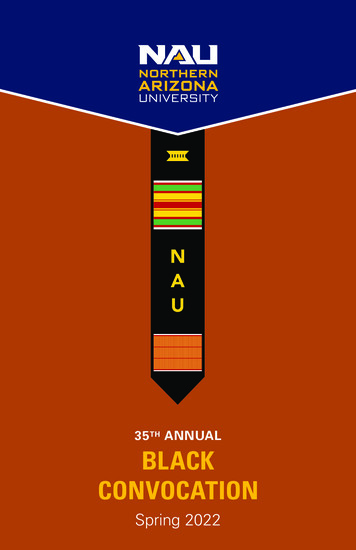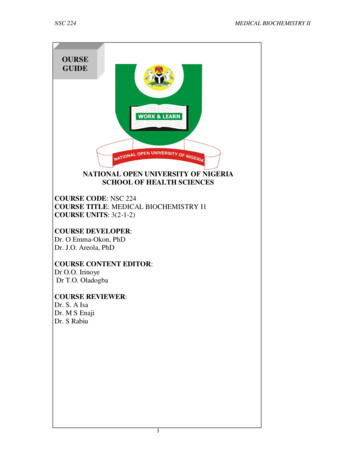
Transcription
NSC 224MEDICAL BIOCHEMISTRY IIOURSEGUIDENATIONAL OPEN UNIVERSITY OF NIGERIASCHOOL OF HEALTH SCIENCESCOURSE CODE: NSC 224COURSE TITLE: MEDICAL BIOCHEMISTRY I1COURSE UNITS: 3(2-1-2)COURSE DEVELOPER:Dr. O Emma-Okon, PhDDr. J.O. Areola, PhDCOURSE CONTENT EDITOR:Dr O.O. IrinoyeDr T.O. OladogbaCOURSE REVIEWER:Dr. S. A IsaDr. M S EnajiDr. S Rabiu1
NSC 224MEDICAL BIOCHEMISTRY IINational Open University of NigeriaHeadquartersUniversity VillagePlot 91, Cadastral Zone,NnamdiAzikiwe Express wayJabi, AbujaLagos Office14/16 Ahmadu Bello WayVictoria Island, Lagose-mail: centralinfo@noun.edu.ngwebsite: www.nou.edu.ngPublished byNational Open University of NigeriaPrint 2017ISBN: ISBN: 978-058-009-3All Rights Reserved2
NSC 224MEDICAL BIOCHEMISTRY IICOURSE CONTENTSPAGEGeneral IntroductionCourse InformationCourse OverviewCourse ObjectivesCourse Implementation - Doing the CourseCourse Requirements and Expectations of YouEquipment and Software Needed to Access CourseNumber and Places of Meeting (Online, Face-To-Face, LaboratoryPractical)Online Discussion ForumCourse EvaluationGrading CriteriaSchedule of Assignments with DatesReference Textbooks for the Course35566777778899
NSC 224MEDICAL BIOCHEMISTRY IIGENERAL INTRODUCTIONLike Medical Biochemistry 1, Medical Biochemistry II is also a subset of generalbiochemistry that focused on the essential components required for the basicunderstanding of allied and health sciences, including nursing sciences. The course dealswith intermediary metabolism and biological oxidation. This course introduces thestudents to different biochemical pathways that break down complex set of ingestedmolecules to functional materials and energy to meet the body’s needs. These pathwaysconstitute what is known as Metabolism. Metabolism is the sum of all of the chemicalreactions that take place in an organism. Metabolic reactions are either catabolic oranabolic. Catabolic reactions break down large molecules and release energy, whileanabolic reactions large molecules and release energy, while anabolic reactions synthesizelarger molecules and require energy. Clinical conditions that are associated withimpairment of the metabolic pathway were also discussed.COURSE AIMThe aim of this course is to introduce students to the basic understanding of intermediarymetabolism and biological oxidation.COURSE OBJECTIVESAt the end of this course, students should be able to understand the different metabolicpathways that breakdown molecules and produce energy. The different pathways that areanabolic and those that are catabolic. The different clinical conditions associated withmetabolic pathways.WORKING THROUGH THE COURSEThe blended learning mode would be adopted in teaching this course: 70% online and30% face-to-face. Only students that have registered for this course would be allowedaccess to study materials and interactive sessions.Study materials (hard and soft copies) would be tailored point-by-point to address thescope of each module.As part of the learning objectives, students are expected to attempt Tutor MarkedAssignments (TMA) and other Self-Assessment Questions (SAQ) provided at the end ofeach module preparatory to in-tests and final examinations to be undertaken at the end ofthe semester. For periodical evaluation of learning and tutor-student interaction, studentsare expected to keep a portfolio where all completed assignments are stored.COURSE MATERIALSThe following course materials would be provided:Lecture notes4
NSC 224MEDICAL BIOCHEMISTRY IIPower point slidesPre-recorded videos andLogbooks for virtual laboratory demonstrationsSTUDY UNITSNSC 224 (Medical Biochemistry II) is a 3 credit units course comprising ofthree (3) modules and 9 study units.TEXT BOOKS AND REFERENCESMurry, R. K., Bender, D. A., Bothan, K.M., Kennelly, P. J., Rodwell, V. W. and Well, P.A. (2015). Harper’s Illustrated Biochemistry (30th Edition) McGraw-Hill Medical.Nelson, D. L. and Cox, M. M. (2012). Lehninger Principles of Biochemistry (6th edition)WH Freeman.Pamela, C. C., Richard, A. H. and Denise, R. F. (2013). Lippincott’s Illustrated ReviewsBiochemistry (6th edition) Lippincott Williams & Wilkins.Marks' Essentials of Medical Biochemistry: A clinical approach. 2nd Edition Copyright2007 Lippincott Williams & Wilkins.Garrett and Grisham Biochemistry, 2nd Edition. Harcourt College PubLippincott Biochemistry Fourth Edition (2010).Robert K. Murray, MD, PhD. ‘Harper’s Illustrated Biochemistry’. Twenty-Eighth Edition.2009Devlin T.M. (2010) Textbook of Biochemistry with Clinical Correlation 7thEdition.JohnWiley & SonsInc.ASSIGNMENT FILEAssignments would be given at the end of each module and submission time would bespelt out accordingly.TUTOR MARKED ASSIGNMENTTo be provided by tutor at the end of each module in addition to the ones already spelt outin the course material.5
NSC 224MEDICAL BIOCHEMISTRY IIFINAL EXAMINATION AND GRADINGThe final written examination will come up at the end of the semester comprising essayand objective questions covering all the contents covered in the course. The finalexamination will amount to 60% of the total grade for the course.GRADING CRITERIAGrades will be based on the following Percentages Tutor Marked Individual Assignments Computer marked Assignment Group assignment Discussion Topic participation Laboratory practical End of Course examinationTotalGRADING SCALE A 70-100 B 60 - 69 C 50 - 59 F 4910%10%5%5%10%60%100%COURSE MARKING SCHEMECourse marking scheme would be provided by the tutor.HOW TO GET THE MOST FROM THIS COURSE Students are expected to participate in all interactions with the tutor and askquestions during lectures Materials recommended for further reading should be used to augment study guidesprovided by the tutor. Importantly, timely submission of assignments and returned marked scripts shouldbe used for self-evaluation Regular participation in online discussion forums and study groups to comparenotes and share ideas Keep in touch with information outlets provided at study centers, Department andNOUN websitesFACILITATORS, TUTORS AND TUTORIALSInformation on Profile of facilitators and tutors for the course would be provided at theDepartment and NOUN websites. Schedule for tutorials would be arranged by facilitatorsand tutors from time to time during the semester.6
NSC 224MEDICAL BIOCHEMISTRY IISUMMARYThe Course NSC 224 (Medical Biochemistry II) is a compulsory course for NursingScience students. The course content is prepared in modules and units. It covers the basicrequirements for teaching medical biochemistry to Nursing Science students. It isexpected that the foundation provided in NSC 224 would find relevance as studentsadvance in their course of study. The minimum pass grade is 50% made up of assignmentsand examination components.7
NSC 224MEDICAL BIOCHEMISTRY IICOURSEGUIDECCONTENTSPAGEModule 1- CARBOHYDRATES METABOLISMContentsUnit1: GlycolysisUnit2: Glycolysis 2Unit 3: Tricarboxylic Acid CycleModule 2- FATTY ACID METABOLISMContentsUnit 1: Fatty Acid OxidationUnit 2: Fatty Acid Oxidation 2Module 3- VITAMINS AND TRACE ELEMENTSContentsUnit 1: The Fat Soluble VitaminsUnit 2: The Fat Soluble VitaminsUnit 3: Trace ElementsModule 4- AMINO ACID METABOLISMContentsUnit 1 Sources of Amino AcidsUnit 2 Disorders of Amino acid MetabolismUnit 3 Diabetes Mellitus8
NSC 224MEDICAL BIOCHEMISTRY IIModule 1: CARBOHYDRATE METABOLISMThis module introduces the students to the major concept in the metabolism ofcarbohydrates. Carbohydrates are the major source of energy for the living cells. Glucoseis the central molecule in carbohydrate metabolism since all the major pathways ofcarbohydrates metabolism are connected with it. The important pathways of carbohydratesmetabolism and associated disorders will be discussed.Module ObjectivesAt the end of this module students should be able to:i. Explain the concept of digestion and absorptionii. Outline the major pathways for carbohydrates metabolism.iii. Discuss the regulation of the major metabolic pathways.iv. Highlight the clinical conditions associated with the pathways.MAIN CONTENTSUnit 1: GlycolysisUnit 2: Glycolysis 2Unit 3: Tricarboxylic Acid CycleUNIT ONE- in Content3.1The glycolytic pathway3.2The stages of glycolytic pathway4.0Conclusion5.0 Summary6.0Tutor Marked Assignments6.1Activity6.2Tutor Marked Tests7.0Reference and other resources1.0IntroductionGlycolysis is the sequence of reactions that converts glucose into pyruvate with theproduction of ATP. In aerobic organisms, glycolysis is the prelude to the citric acid cycleand the electron transport chain, where most of the energy contained in glucose isreleased. Under aerobic conditions, pyruvate enters the mitochondria where it iscompletely oxidized to CO2 and H2O.If the supply of oxygen is insufficient, e.g. inactively contracting muscle, pyruvate is converted into Lactate. In some anaerobicorganisms, pyruvate is transformed into ethanol. The formation of ethanol and Lactatefrom Glucose are examples of fermentations. Reactions of glycolysis take place in the9
NSC 224MEDICAL BIOCHEMISTRY IIcytosol. Glycolysis is sometimes called the Embden Meyerhof pathway, after GustavEmbden and Otto Meyerhof who made significant contributions to its elucidation in 1940.2.0ObjectivesAt the end of this unit, you should be able to:i.Explain the concept of Glycolysisii. State the importance of the glycolytic pathwayiii. Enumerate the different reactions which make up the pathway and the enzymeswhich catalyze these reactions3.0Main Content3.1 Overview of digestion and absorption of CarbohydratesDigestion is the hydrolysis of complex food molecules into smaller water solublemolecules that can easily be absorbed by the gastrointestinal tract for utilization by thecells. The organs of the digestive tract usually have a large reserve capacity. Pancreas forexample secretes enzymes five to ten folds higher than required for digestion of foodsingested.Digestion of carbohydrates usually starts in the mouth, where food material comes incontact with saliva during mastication. Saliva contains a carbohydrate splitting enzymecalled salivary amylase (ptyalin). The enzyme hydrolyzes α- (1,4) glycosidic linkages instarch, glycogen and dextrins, producing smaller molecules like maltose, glucose anddisaccharides maltotriose. Ptyalin action stops in stomach when pH falls to 3.0. Nocarbohydrate splitting enzymes are available in gastric juice. HCl may hydrolyze somedietary sucrose to equal amounts of glucose and fructose. Food reaches the duodenumfrom stomach where it meets the pancreatic juice. Pancreatic juice contains acarbohydrate-splitting enzyme pancreatic amylase. Like ptyalin it also requires Cl- foractivity. The enzyme hydrolyzes α-(1,4) glycosidic linkage situated well insidepolysaccharide molecule. Other criteria and end products of action are similar of ptyalin.The final digestion of di- and oligosaccharides to monosaccharides primarily occurs at themucosal lining of the upper jejunum. This is carried out by oligosaccharidases anddisaccharidases. Lactase, maltase and sucrase are example of disaccharidases.The principal monosaccharides produced by the digestion process are glucose, fructoseand galactose. Glucose account for nearly 80% of the total monosaccharides. Theabsorption of sugars mostly takes place in the duodenum and upper jejunum of smallintestine.Two mechanisms are involved in absorption of sugars. Simple Diffusion and activetransport mechanism. Simple diffusion is dependent on sugar concentration gradientsbetween the intestinal lumen, mucosal cells and blood plasma. All the monosaccharidesare probably absorbed to some extent by simple ‘passive’ diffusion.On the other hand, Glucose and galactose are absorbed very rapidly and hence it has beensuggested that they are absorbed actively and it requires energy. Glucose and Na share thesame transport system (symport) called sodium-dependent glucose transporter. Fructose10
NSC 224MEDICAL BIOCHEMISTRY IIabsorption is also rapid but not so much as compared to glucose and galactose but it isdefinitely faster than pentoses. Hence fructose is not absorbed by simple diffusion aloneand it is suggested that some mechanism facilitates its transport, called as” facilitatedtransport”.3.2The glycolytic pathwayThe word glycolysis is derived from the Greek glykys meaning sweet and lysis meaningsplitting. Glycolysis is a linear, 10-step pathway that converts glucose, a six-carbonmonosaccharide, to two molecules of pyruvate (CH3COCO2 –).Glycolysis takes place entirely in the cytosol, whereas, pyruvate oxidation occurs in themitochondrial matrix where ATP is generated. Oxygen is not required for glycolysis inthe cytosol (anaerobic) but it is necessary for aerobic respiration in the mitochondrialmatrix where the O2 serves as the terminal electron acceptor.Glycolysis is an ancient pathway that cleaves glucose (C6H12O6) into two molecules ofpyruvate (C3H3O3). Under aerobic conditions, the pyruvate is completely oxidized by thecitrate cycle to generate CO2, whereas, under anaerobic (lacking O2) conditions, it is eitherconverted to lactate, or to ethanol CO2 (fermentation).The glycolytic pathway consists of ten enzymatic steps organized into two stages. InStage 1, two ATP are invested to “prime the pump,” and in Stage 2, four ATP areproduced to give a net ATP yield of two moles of ATP per mole of glucose.Three glycolytic enzymes catalyze highly exergonic reactions ( G 0) which drivemetabolic flux through the pathway; these enzymes are regulated by the energy charge inthe cell (ATP requirements). The three enzymes are hexokinase, phosphofructokinase 1,and pyruvate kinase.Glycolysis generates metabolic intermediates for a large number of other pathways,including amino acid synthesis, pentose phosphate pathway, and triacylglycerol synthesis.3.3The stages of glycolytic pathwayThe glycolytic pathway can be divided into three stages.Stage OneThe conversion of Glucose to fructose 1,6 Biphosphate. This stage comprises of 3steps- a phosphorylation, an isomerization and another phosphorylation.i.Glucose is phosphorylated by ATP to form glucose 6-phosphate. This reaction iscatalyzed by Hexokinase (An enzyme that transfers a phosphoryl group from ATPto an acceptor is called a kinase) .Glucose ATPGlucose 6-phosphate ADP Pi11
NSC 224MEDICAL BIOCHEMISTRY IIGlucose 6-phosphate is isomerized to Fructose 6-phosphate. The reaction iscatalyzed by Phospho glucose isomerase.iii. Fructose 6-phosphate is phosphorylated by ATP to Fructose 1,6-biphosphate.Fructose 6- phosphate ATPFructose 1,6-biphosphate ADP H This reaction is catalyzed by phosphofructokinase, an allosteric enzyme. The pace ofglycolysis is critically dependent on the level of this enzyme. Its catalytic activity iscontrolled by ATP and other metabolites.ii.Stage TwoThis stage of glycolysis consists of 4 steps, starting with the splitting of Fructose 1,6biphosphate to yield glyceraldehyde 3-phosphate and dihydroxyacetone phosphate. Theremaining steps in glycolysis involve 3 carbon units rather than 6 carbon units.(iva) Fructose1,6-biphosphateDihydroxyacetonephosphate Glyceraldehyde 3-phosphateThe reaction is catalyzed by aldolase. The 2 products formed are isomers.Dihydroxyacetone phosphate is a ketose while glyceraldehydes 3-phosphate is analdose. The reaction proceeds readily from DAP to TPI through the action of theenzyme triose phosphate isomerase. Thus, 2 molecules of glyceraldehyde 3phosphate are formed from one molecule of Fructose 1,6 biphosphate.(v)G l yc e r a l d e h yd e 3 - p h o s p h a t eD i h yd r o x ya c e t o n ephosphate.Conversion of glyceraldehydes 3-phosphate to 1,3 –diphosphoglycerate,catalysed by glyceraldehyde 3-phosphate dehydrogenaseGLY 3-P NAD PI1,3 DPG NADH H ( v i i)1,3 Diphosphoglycerate is converted to 3-phophoglycerate, and ATP isgenerated. The rxn is catalyzed by phosphoglycerate kinase.1,3 Diphosphoglycerate ADP3-Phosphoglycerate ATP(vi)Stage ThreeIn this stage, three steps are involved leading to the generation of pyruvate(viiia) 3-phosphoglycerate is converted to 2-phosphoglycerate, through the action of2-phosphoglyceromutase.(ixa) 2-phosphoglycerate is converted to phosphoenolpyruvate by Enolase2-PhosphoglyceratePhosphoenol pyruvate H2O(xa) PEP is converted to Pyruvate with the generation of ATP, the rxn beingcatalyzed by pyruvate kinase.PEP ADP PiPyruvate ATPThe net reaction in the conversion of Glucose into pyruvate isGlucose 2Pi 2ADP 2NAD 2Pyruvate 2ATP 2NADH 2H 2H2O12
NSC 224MEDICAL BIOCHEMISTRY IIFig 1.1: The Glycolytic PathwaySelf-Assessment Exercises1. Outline the steps where ATP hydrolysis and synthesis takes place in glycolysis.2. Write down the net reaction of glycolysis,4.0ConclusionGlycolysis is an ancient pathway that cleaves glucose (C6H12O6) into two molecules ofpyruvate (C3H3O3). This reaction take plaace in the cytosol. Glycolysis generatesmetabolic intermediates for a large number of other pathways, including amino acidsynthesis, pentose phosphate pathway, and triacylglycerol synthesis5.0i.ii.iii.Summary: In this unit, you have been exposed to:The basic concept of the digestion and absorption of carbohydrates.The key concepts of GlycolysisThe stages of glycolysis reactions13
NSC 2246.0i.ii.iii.MEDICAL BIOCHEMISTRY IITutor Marked AssignmentsExplain the basic concept of GlycolysisState the importance of the glycolytic pathwayEnumerate the different reactions which make up the pathway and the enzymeswhich catalyze these reactions7.0 References and Further ReadingKatherine, M. A. Rogers and William N. Scott (2011). Nurses! Test yourself inanatomy and physiologyKathryn, A. Booth, Terri. D. Wyman (2008). Anatomy, physiology, andpathophysiology for allied healthKeith L.M, Persuade T.V.N (2006). The Developing Human Clinically OrientedEmbryology; 8th Edition Lippincott Williams & WilkinsKent, M. Van De Graff, R.WardRhees, Sidney P. (2010). Schaum’s outline of humananatomy and physiology 3rd edition.Philip, T. (2012). Seeley’s principles of anatomy & physiology 2nd edition.Sadler, T.W (2004). Langman’s Medical Embryology 9th edition.14
NSC 224MEDICAL BIOCHEMISTRY IIUNIT TWO- GLYCOLYSIS IICONTENT1.0 Introduction2.0 Objectives3.0 Main Content3.1 Consumption and generation of ATP in Glycolysis3.2 Regulation of Glycolysis3.3 Regulation of Glycolysis3.4 Clinical conditions associated with impaired Glycolysis4.0 Conclusion5.0 Summary6.0 Tutor Marked Assignments7.0 Reference and other resources1.0 IntroductionWe continue our discussion of the glycolytic pathway. 2 ATP molecules are produced inthe course of the pathway. However, more ATP is produced when pyruvate is completelyoxidized to CO2 and H2O in the mitochondria. The glycolytic pathway is regulatedthrough the activities of 3 enzymes that catalyze its irreversible reactions. However, themost important control element of glycolysis is the enzyme phosphofrctokinase (PFK),the enzyme catalyzing the first irreversible step unique to the pathway. Pyruvate has 3fates- It may be converted to acetyl coA, ethanol or Lactate. Clinical conditionsassociated with impaired glycolysis include Lactic acidosis and Pyruvate kinasedeficiency.2.0ObjectivesAt the end of this unit, you should be able to:i.Give the gross and net ATP yield of glycolysisii.List the glycolytic regulatory enzymes and their corresponding effectors.iii. Explain the fates of Pyruvateiv. List and explain some disorders of Glycolytic pathway3.0Main Content3.1Consumption and generation of ATP in GlycolysisThe following table provides an outline of how ATP is consumed and produced duringglycolysis, with a net production of 2 ATP molecules. Most of the energy contained inglycolysis is harvested in the TCA cycle and the electron transport chain.ReactionATP change per glucoseGlucoseGlucose 6-Phosphate-1Fructose6-phosphatefructose 1,6-biphosphate-12 1,3-Biphosphoglycerate2 3-phosphoglycerate 215
NSC 224MEDICAL BIOCHEMISTRY II2 PEP2 Pyruvate 2Net 23.2Regulation of GlycolysisThe glycolytic pathway has a dual role (i) It degrades glucose to generate ATP and (ii) Itprovides building blocks for synthetic reactions. The rate of conversion of glucose intopyruvate is regulated to meet these 2 major cellular needs. Enzymes catalyzing essentiallyirreversible reactions are potential sites of control. In glycolysis, the reactions catalyzedby Hexokinase ( HK), phosphofructokinase ( PFK) and Pyruvate kinase (PK) are virtuallyirreversible, and so these enzymes play regulatory as well as catalytic roles.However, PFK is the most important control element in glycolysis. The enzyme isinhibited by(i) High levels of ATP. ATP binds to to a highly specific regulatory site that isdistinct from the catalytic site. The inhibitory action is reversed by AMP.Theactivity of the enzyme increases when the ATP/AMP ratio is lowered.(ii)High levels of Citrate, which indicates that biosynthetic precursors are abundant.Citrate inhibits PFK by enhancing the inhibitory effect of ATP. Hexokinase and Pyruvatekinase also participate in regulating the rate of glycolysis. In general, the enzymecatalyzing the committed step (the first irreversible reaction unique to a pathway) in ametabolic sequence is the most important control element in the pathway. PFK is mostactive when the cell needs both energy and building blocks. It is moderately active wheneither energy or a carbon skeleton is needed. The enzyme is almost switched off whenboth are abundant.Hexokinase and Pyruvate kinase also participate in regulating the rate of glycolysis.Pyruvate kinase from muscle and liver is allosterically inhibited by ATP, so theconversion of PEP to pyruvate is blocked when the energy charge is high. Hexokinase isallosterically inhibited by glucose 6 –phosphate. The level of F6P increases when PFK isblocked, and so there is a corresponding increase in the level of G6P, which is inequilibrium with F6P.Hence, inhibition of PFK leads to the inhibition of HK.3.3 Regulation of GlycolysisThe fate of pyruvate in the generation of metabolic energy in different organisms anddifferent kinds of cells varies.1. Pyruvate can be converted to Ethanol, Lactate or Acetyl CoA.Ethanol is formed from pyruvate in yeast and several other microorganisms in 2 steps asfollows( i) P yru vate H Ace tald eh yd e CO2(ii)(ii) Acetaldehyde NADH H Ethanol NAD The conversion of glucose into ethanol is called alcoholic fermentation. Thenet reaction isGlucose 2Pi 2ADP 2H 2Ethanol 2CO2 2ATP 2H2O16
NSC 224MEDICAL BIOCHEMISTRY II2. Lactate is formed from pyruvate in many microorganisms as well as in cells ofhigher organisms when the amount of oxygen is limiting e.g in muscle during intenseactivity.Pyruvate NADH H L-Lactate NAD The net reaction for the conversion of glucose to lactate isGlucose 2Pi 2ADP2Lactate 2ATP 2H2O3. A lot of energy is derived aerobically by means of TCA cycle and electrontransport chain. The entry point to this oxidative pathway is acetyl coenzyme A(Acetyl CoA), which is formed inside mitochondria by the oxidative decarboxylationof Pyruvate:Pyruvate NAD CoAAcetylcoA CO 2 NADHThe reaction is catalyzed by the Pyruvate dehydrogenase complex3.4Clinical conditions associated with impaired GlycolysisLactic AcidosisThis is the most frequent form of metabolic acidosis. It can occur as a result ofoverproduction of lactate, underutilization of Lactate or inhibition of pyruvatedehydrogenase. It may also be as a result of rare congenital disorders where themitochondria do not function at full capacity or diabetic ketoacidosis as well asliver/kidney disease. It is characterized by Lactate levels 5mM/L and serum pH 7.35Symptoms: Nausea, Vomiting, Hyperventilation, Irregular heart rate.Pyruvate Kinase deficiencyA rare genetic defect of glycolysis causes haemolyticanaemia. Glycolytic intermediatesclose to the pyruvate kinase step accumulate, whereas pyruvate and Lactateconcentrations decrease. Lysis of the RBCs may cause jaundice from increased Bilirubin.4.0 ConclusionTwo molecules of ATP molecules are produced in the glycolytic pathway. However, moreATP is produced when pyruvate is completely oxidized to CO2 and H2O in themitochondria. Regulation of glycolytic pathway is achieved through the activities of 3enzymes that catalyze its irreversible reactions. The most important control element ofglycolysis is the enzyme phosphofrctokinase (PFK), the enzyme catalyzing the firstirreversible step unique to the pathway. Pyruvate has 3 fates- It may be converted to acetylcoA, ethanol or Lactate. Clinical conditions associated with impaired glycolysis includeLactic acidosis and Pyruvate kinase deficiency.5.0Summary: In this unit, you have learnt about the following:i.Consumption and generation of ATP in Glycolysisii.Regulation of Glycolysisiii. Clinical conditions associated with impaired Glycolysis17
NSC 224MEDICAL BIOCHEMISTRY II6.0i.ii.iii.iv.Tutor Marked AssignmentsGive the gross and net ATP yield of glycolysisList the glycolytic regulatory enzymes and their corresponding effectors.Explain the fates of Pyruvate.List and explain some disorders of Glycolytic pathway7.0References and Further readingKatherine, M. A. Rogers and William N. Scott (2011). Nurses! Test yourself inanatomy and physiologyKathryn, A. Booth, Terri. D. Wyman (2008). Anatomy, physiology, andpathophysiology for allied healthKeith L.M, Persuade T.V.N (2006). The Developing Human Clinically OrientedEmbryology8th Edition Lippincott Williams & WilkinsKent, M. Van De Graff, R.WardRhees, Sidney P. (2010). Schaum’s outline of humananatomy and physiology 3rd edition.Philip, T. (2012). Seeley’s principles of anatomy & physiology 2nd edition.Sadler, T.W (2004). Langman’s Medical Embryology 9th edition.18
NSC 224MEDICAL BIOCHEMISTRY IIUNIT THREE- TRICARBOXYLIC ACID CYCLECONTENTS1.0 Introduction2.0 Objective3.0 Main Content3.1 Description of TCA cycle3.2 The Amphibolic Nature of the TCA Cycle3.3 The Anaplerotic Nature of the TCA Cycle3.4 The relationship between TCA cycle and Beriberi3.5 Summary of oxidative phosphorylation3.6 Inhibitors of electron transport chain4.0 Conclusion5.0 Summary6.0 Tutor Marked Assignments6.1 Activity6.2Tutor Marked Tests7.0Reference and other resources1.0IntroductionThe citric acid cycle was discovered by Hans krebs in 1937 and received Nobel prize forthe discovery in 1953. The cycle was therefore named after him as kreb’s cycle. The cycleis also known as citric acid cycle or tricarboxylic acid cycle. The citric acid cycle is thefinal common pathway for the oxidation of fuel molecules (protein, fatty acids andcarbohydrates) to energy, carbon dioxide and water. Without this cycle, most of the foodwe eat cannot be converted to energy. Most of these fuel molecules are metabolized toacetyl Coenzyme A (acetyl CoA) or intermediates of the cycle. The acetyl CoA generatedis then fed into the cycle and condenses with oxaloacetate. Two molecules of CO2 isliberated, the energy released is conserved in the reduced electron carriers NADH andFADH2. In the final stage the conserved energy is released and stored as ATP.2.0ObjectivesAt the end of this unit, you should be able to:i. Describe TCA cycle in detailii. Explain the Amphibolic nature of the TCA cycleiii. Explain the Anaplerotic nature of the TCA cycleiv. Describe the relationship between this cycle and Beriberi (a neurological disease)v. Give the summary of oxidative phosphorylationvi. Give examples and describe the inhibition of electron transport chain3.0Main Content3.1Description of TCA cycleIn eukaryotes, TCA cycle takes place in the mitochondria because all the enzymes of thecycle are located inside the mitochondria matrix. The TCA cycle is an important source of19
NSC 224MEDICAL BIOCHEMISTRY IIprecursors or building blocks for the synthesis of molecules such as amino acids, purinebases, cholesterol and porphyrins.The cycle starts when a four-carbon compound (oxaloacetate) condenses with a twocarbon acetyl unit of acetyl coA to yield a six carbon tricarboxylic acetate (citrate). In acyclic series of reactions (figure 2.1) the isomer of citrate (isocitrate) isoxidativelydecarboxylated (one molecule of CO2 is released). The resulting five carboncompound, α-ketoglutarate is also oxidativelydecarboxylated (another molecule of CO2 isalso released) to yield a four-carbon compound (succinate). Oxaloacetate, the startingmaterial is eventually regenerated through the formation of fumarate and malate.Oxaloacetate’s function in kreb’s cycle can be described as catalytic in nature because thecompound participates in the oxidation reaction and it is regenerated at the end of thecycle. Carboxylation of pyruvate is the major source of oxaloacetate as the startingmaterials for the cycle.20
NSC 224MEDICAL BIOCHEMISTRY IIFigure 3.1: The TCA cycle showing the enzymes and the intermediates (source googleimages).3.2The Amphibolic Nature of the TCA CycleThe citric acid cycle functions as catabolic pathway when it is used to break down acetylCoA to two molecules of CO2, water and energy. Whenever the energy level of the cell islow, catabolic pathway is favoured. The sole purpose of the TCA cycle when it isoperating as catabolic pathway is the oxidation of acetate to CO2, with concomitantconservation of the energy of oxidation as reduced coenzymes and eventually as ATP.The cycle also functions as anabolic pathway when there is sufficient energy reserve inthe cell. The pathway is used to supply building blocks for the synthesis of variousbiological molecules. The function of the cycle at a particular time is determined by theenergy conditions of the cell, because of its dual functions,it is referred to as anamphibolicpathway.3.3The Anaplerotic Nature of the TCA CycleBasically, the TCA cycle has a single substrate, and the substrate is ace
2007 Lippincott Williams & Wilkins. Garrett and Grisham Biochemistry, 2 nd Edition. Harcourt College Pub Lippincott Biochemistry Fourth Edition (2010). Robert K. Murray, MD, PhD. 'Harper's Illustrated Biochemistry'. Twenty-Eighth Edition. 2009 Devlin T.M. (2010) Textbook of Biochemistry with Clinical Correlation 7th Edition.


